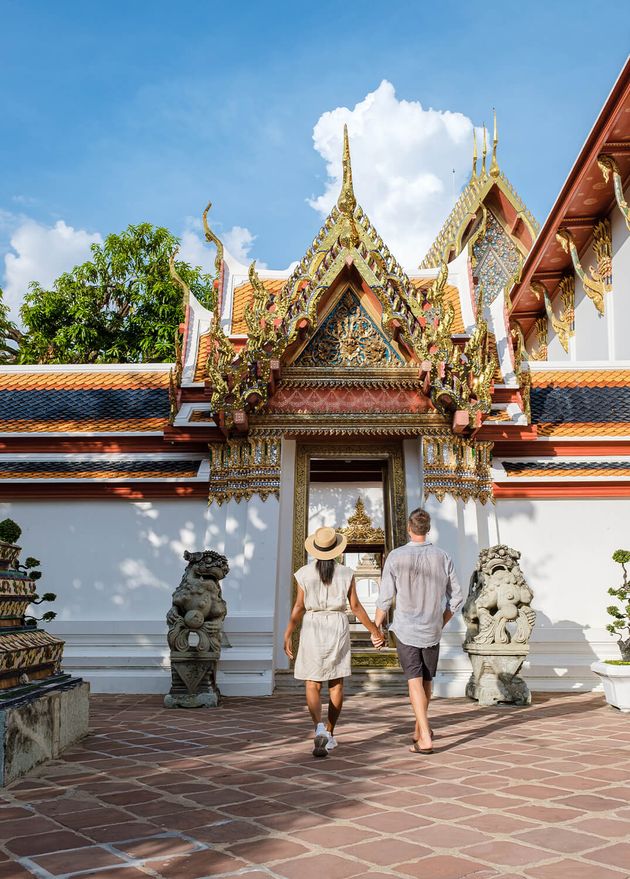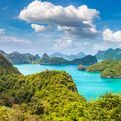Wat Phra Chetuphon: Exploring Rattanakosin Island's Temple Gem
The stunning destinations of Thailand are not only distinguished for their considerable natural beauty but also for nightlife. There are numerous hot spots in this country due to its distinctive culture. Buddhism has dominantly influenced the culture of this gorgeous country, and it is evident in many of its enchantments. Many spectacular temples in Thailand are rooted in Buddhism and Hinduism.
Wat Pho Temple (Wat Phra Chetuphon) is one of the many outstanding ancient places in Krung Thep Maha Nakhon (Bangkok), and I’m pretty sure it’s also on your journey to the city. Thousands of people from all over the world visit this incredible temple in the capital each year, mainly to see its great Reclining Buddha statue and the proud history of the temple.
So, if you’ll be one of them soon, this article will definitely tell you everything you wish to know!
Wat Pho has good English-speaking guides who will deliver delightful knowledge for around 200 or 400 baht. The price depends on how many people there are in your group and how good your negotiating techniques are. If you like, you can roam alone.
Wat Phra Chetuphon in Rattanakosin island
Wat Pho in Krung Thep Maha Nakhon (Bangkok) is one of the city's most ancient, prominent, and significant temples. This 20-acre site is second to the Grand Palace as one of the top tourist attractions in the city.
It is not only one of the most visited Buddhist temples in Krung Thep Maha Nakhon (Bangkok) but also where history, medical science, and educational academies are incorporated. From then, it was officially named Wat Phra Chetuphon Vimon Mangkalaram. Wat Pho was assumed to be established during the 16th century, and later, it served as The Royal Temple of King Rama I of the Chakri Dynasty.
Along with housing one of the world's most popular reclining Buddha sculptures, more than 1,000 other Buddha images are conserved within the temple floors. Wat Pho is the home of Thai massage and is a critical center for exploring traditional medicine. The temple was created during the Empire of Rama I. Wat Pho underwent more formation in 1788 when the King supposedly wished to make it more comprehensive.
King Rama I’s ashes are buried in the ordination hall of Wat Pho. The Bohr was designed when King Rama III was in power. Therefore, much of the temple’s architecture is Ayutthaya-style. Many other buildings in the temple grounds were built from the salvaged remains of the temple town of Ayutthaya, but not all of them.
However, the temple complex is large and takes at least an hour to explore properly. The different structures hold artifacts and give enthusiastic relief to convey their loyalty. Although it is undoubtedly traditional, it is also neat and well-maintained. The crowds of visitors bring in a reasonable income. I’m sure, and it’s fair to know that much of that is consumed on the maintenance of Wat Pho.
Stunning Attractions Around Wat Pho on Rattanakosin Island
The Reclining Buddha
The most evocative site in the temple complex is the Reclining Buddha, a Buddha statue in the enlightenment posture. The statue is tremendous. It’s 15 meters tall and 46 meters long. The Buddha’s feet are 5 meters long and painted with beautiful portrayals and elements of Buddha. Second of all, the statue is coated in gold leaf.
108 Coins
For 20 Thai Baht ($ 0.65), you can buy a small bowl with 108 coins. As a meditative process, you walk along the wall behind the reclining Buddha and drop a coin in each of the 108 buckets. 108 is a sacred number in Buddhism, and the coins you donate as this meditation is used to maintain the temple. And you can similarly make a wish!
The Temple Complex
Except for the well-known Reclining Buddha, there are some other cool things to respect on the site. For example, there are 4 chapels with elegant Buddha images, gold Buddha statues rounded up, complex murals, and some freshly superb and colorful stupas and Chinese statues in the enclosures.
Furthermore, within the courtyard stands a tree known as the Bodhi tree, believed to have grown from the actual tree Buddha sat under during meditation. This is one of the most riveting factors of visiting Wat Pho, primarily for Buddhists. Visitors can access all these with their entrance ticket and even book a guide on-site.
Royal Chedi
On the western side of the floor is an assortment of four towering tiled chedis observing the first four Chakri kings. Note the square bell shape with various closets, an impression of Ratanakosin style, and the titles pretending to be the colors of the Buddhist flag.
Wat Pho
Wat Pho is supposed to be the first general institute for teaching Thai Massage. They furthermore teach Thai medicine in this temple, and you can receive a variety of traditional Thai massages here. Although you can search and discover a reasonable rate out and about, the historical importance of this school looks to draw in visitors.
The loveliest time to visit the temple is at dawn when it opens. This way, you will skip both the sharp noon warmth and the severe crowds that come hand in hand with so many of the prominent temples in Bangkok. Mostly avoid attending on weekends or public holidays. It also gets relatively busy in the afternoons.
Essential Guidelines When Visiting Wat Pho
Like most places of worship, the temples in Krung Thep Maha Nakhon (Bangkok) have a strict dress code for those wishing to visit. The most significant thing to know is to cover your knees and shoulders and to remove your shoes before arriving at the Reclining Buddha room. Similarly, a dress code is precisely executed when visiting the Grand Palace. You’ll be rejected if you turn up in shorts.
- The knees and shoulders should be covered.
- Don’t wear shirts illustrating religious themes or images of death
- Avoid stretch pants and any other uncovering clothing.
- Remove hats, headphones, and sunglasses.
Why Visit Wat Pho on Rattanakosin Island?
99% of people visit Wat Pho to discover the Reclining Buddha, which is 100% a legit motive to visit because it is the temple's highlight! Aside from the remarkable statue of the Reclining Buddha, the whole temple complex of Wat Pho is beautiful, and it’s full of detailed symbols and golden Buddha images in the shapes of statues and paintings. So, a visit here is worth it!
Wat Pho was once Thailand’s first public university with a priority on science, literature, and religion. More than 1300 descriptions of marble speak about medical sciences around the temple complex. Wat Pho was believed to be founded in the 16th century and later used as a Royal Temple for King Rama I of the Chakri Dynasty.
Nowadays, Wat Pho is one of the most famous Buddhist temples in Bangkok and a well-known traditional Thai massage and medical center. Moreover, Wat Pho has been a UNESCO Memory of the World since 2008.
How to Visit Wat Pho on Rattanakosin Island?
Wat Pho is situated on Rattanakosin Island, the former part of Krung Thep Maha Nakhon (Bangkok), on the Eastern side of the Chao Phraya River. It is placed directly South of the Grand Palace.
There are many ways to visit Wat Pho on Rattanakosin Island. You can check out our Thailand Transport System: Everything You Need to Know article, or if you have your own car, you can also check out our guide on Private Vehicles in Thailand: Everything You Need to Know. However, the most thrilling way to get to Wat Pho is by river taxi. Boats are cheap and enable you to bypass city traffic.
When you take the Chao Phraya Express boat to Tha Tien Pier, observe signs a short distance from the entrance of Wat Pho. The nearest MRT station to Wat Pho is Sanam Chai. It is an 8-minute walk to the south. Unfortunately, the BTS Skytrain doesn’t arrive at Rattanakosin Island.
Some taxi drivers who won’t turn on the meter might trick first-time travelers into Wat Pho. Tuk-tuk drivers are even awful. Only use a metered taxi or Grab, one of Southeast Asia’s most prominent rideshare apps.
You will charge an entrance fee of 200 Thai Baht ($6.40). This fee comprises a small water bottle as well. Your ticket authorizes you to visit everything in the temple complex without any excess fees. The massage is paid for separately.
Maps & More Information
Wat Pho is set near the Chao Phraya River in Krung Thep Maha Nakhon (Bangkok), otherwise known as the Temple of the Reclining Buddha. It is one of the oldest and biggest wats, or temples, in the country, and every traveler to the Land of Smiles should attend this religious structure.
|
Entrance Fee |
200 THB for Foreigners Free for Children under 4 feet tall |
|
Business Address |
2 Sanam Chai Rd, Phra Borom Maha Ratchawang, Phra Nakhon, Bangkok 10200 |
|
Business Hours |
08:00 - 18:30 | Monday – Sunday |
|
Phone Number |
+66 (0) 830 577 100 |
|
Website |
|
|
Facebook Page |
|
|
GPS |
13.7464237, 100.4927733 |
The Bear Team
We, The Bear Team, are a united group of digital experts and adventurers. Combining technical skills with creative flair, we deliver informative, valuable, up-to-date content. Whether seeking travel inspiration or innovative solutions, we're your go-to for fun, authentic, impactful, and timeless experiences.
The Bear Travel | Experience like a Local
A fast-growing Thailand Travel Blog written by Expats and Thais since 2017. We will share our experiences and ideas from an insider point of view for you to create your own unique Thailand experience.
For the latest news and events about The Bear Travel, follow us on Facebook, Instagram, Twitter, Pinterest, or YouTube.
For any issues, concerns, or queries, don’t hesitate to CONTACT us.
Recommended for you
3 Days in Thailand: How Much Money Do I Need?
Dr. Theodore (Professor Bear)
Holidays in Thailand: Celebrating New Year with Best Wishes and Good Luck
Marc Tubelleja (Curious Bear)
Thailand's National Parks: A Glimpse into Nature and Wildlife
Dr. Theodore (Professor Bear)
Chaipura KC Resort: Escape to Paradise in Koh Chang
The Bear Team
Travel to Pattaya Guide: Everything You Need to Know
The Bear Team
Temples in Thailand: The Ultimate Guide to Visiting & Cultural Etiquette
Dr. Theodore (Professor Bear)























